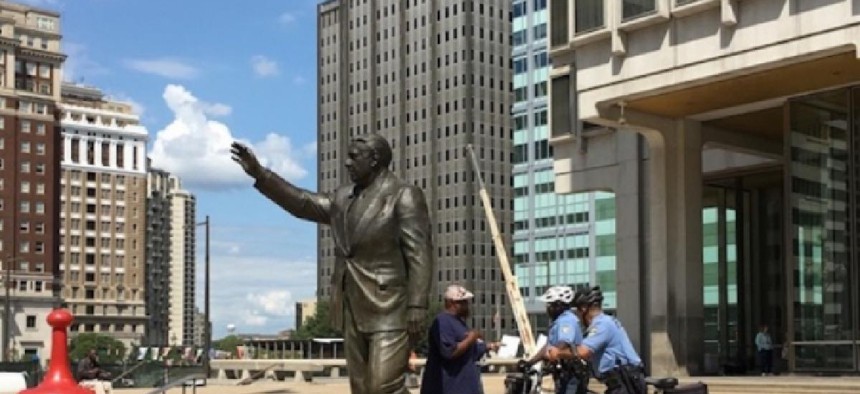The monumental cost of guarding Philly’s Rizzo statue

Two Philadelphia Police Department bike cops stand watch over the statue of the late Philadelphia Mayor Frank Rizzo in front of the Municipal Services Building – photo by Ryan Briggs
Frank Rizzo was a cop’s cop before he was a cop’s mayor. A onetime beat patrolman, he always made sure his boys in blue were taken care of when he ruled over City Hall during his two terms as mayor in the 1970s.
Now, from beyond the grave, Rizzo is still helping ensure Philly cops walk home with fatter paychecks. Police overtime costs have soared as officers have been deployed to guard a statue of the former mayor that has become a flashpoint for citizens who feel there is no place for a monument to what they see as Rizzo’s legacy of racism and oppression.
A protest rocked downtown Philadelphia last week, largely in reaction to a white supremacist rally in Charlottesville, VA, that culminated in the death of counter-protester Heather Heyer. That same incident, triggered in part by an effort to remove Confederate statues in Charlottesville, compelled Councilmember Helen Gym to reiterate a call to topple the 10-foot statue of Rizzo across from City Hall.
The “Philly is Charlottesville” march down Broad Street last Wednesday drew about a thousand participants and similar ire voiced against the Big Bambino’s likeness, as people like police accountability activist Asa Khalif, of Black Lives Matter, repeatedly called for the statue’s relocation.
“Rizzo statue's going down one way or another," Khalif told an Inquirer reporter, although he added that the march was not the time or place to do so.
But police had already swarmed the location hours earlier with a platoon of officers and barricades ringing the statue. As the march concluded in the early evening, a few dozen protesters continued to picket the statue into the night. A lopsided standoff ensued, featuring scores of plainclothes civil affairs officers, bicycle-mounted Police Strike Force cops and busloads of SWAT team members on the other side of the protesters.
The Mayor’s Office said that this one march led to about $100,300 in overtime costs – not to mention the cost to taxpayers for the deployment of dozens of State Troopers, transit police and sheriff’s deputies also on duty at Wednesday’s march and aftermath.
By comparison, the city tallied $292,000 in protest-related police overtime during the entire month of July, which featured more than a half-dozen notable rallies. A spokesperson for Mayor Jim Kenney said protest-related overtime for fiscal year 2017 – rocked by anti-Trump rallies, police shootings and more – had totaled some $5.26 million.
SEPTA Police Chief Thomas Nestel said flooding even minor protests with officers was a deliberate strategy for his department, which is separate from the Philadelphia Police Department.
“I can only speak for my department. I want enough officers in case something happens. Once it happens, it's too late to bring officers in,” he said. “Any belief that I pay overtime because I want the cops to get more money is outlandish.”
Nestel said his office had not yet tabulated overtime costs for the week of the protest.
Over the past week, the statue has been egged and scrawled with graffiti, drawing renewed police protection for the inanimate avatar of the erstwhile mayor. A mural dedicated to Rizzo in South Philly that was also defaced didn’t make the cut for police protection.
The day after the Broad Street march, about 10 officers kept watch over Hizzoner. The overtime for that day: $3,851, according to the Office of the Mayor. (A PPD source said that the average overtime rate for a patrolman is around $50 an hour.)
Security has relaxed since, but a squad car and uniformed officers have alternated on guard duty ever since. On Friday, two bike cops continued to stand watch over the statue.
This post has been updated to reflect the addition of the overtime cost of police officers on duty the day after the march.